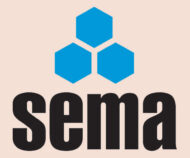Our first query this month Is looking for clarification on missing pins and securing column guards and our second asks about Separating Pedestrians from FLT.
 Missing Pins and Loose Column Guards
Missing Pins and Loose Column Guards
Q. I recently performed a monthly inspection usually performed by a colleague and I found a number of issues, mainly missing pins or loose column guards.
My colleague has suggested that the 15 faults identified are not necessary. To aid my response can you advise me on the following points?
If a guard has four holes for fitting to the ground must all four holes be secured with heavy duty anchor bolts or are two bolts in diagonal corners adequate.
Should all missing nuts from a guard be replaced or repaired.
If the racking is used as a picking location with lightweight products does it require locking pins?
A. There is no SEMA requirement for a column guard to be fitted to the floor in any particular way and recommendations on this should be provided by the manufacturer. Fitting bolts diagonally would only seem to work if the direction of impact can be predicted with some certainty which, in most warehouses, would seem unlikely.
If only two bolts are being used then the manufacturer’s statement that this is an acceptable practice should be obtained. Perhaps some test data from the manufacturer’s product testing programme should be requested to confirm that this provides resistance to impacts from all directions.
If nuts are missing off bolts then they need to be replaced; if this can be done and a satisfactory joint obtained then there is no problem otherwise the whole nut and bolt fitment needs to be replaced.
As far as locking pins are concerned, these are normally required for all pallet racks. If some pallet racking has been decked out and is being used as hand loaded shelving and cannot be approached by mechanical aisle equipment then it can be argued that beam locks are not required as there is no possibility of the beam being accidentally lifted out of position. In this case the racking is the same as ordinary shelving.
If the picking operation is being done with mechanical equipment that could accidentally lift a beam or, if the product in the rack is being replenished by pallet truck which could do the same then beam connector locks are necessary. If not, then the rack can probably be considered as heavy duty shelving rather than racking.
Irrespective of the chosen solution the provision of beam locks should be consistent.
Separating Pedestrians from FLT
Q. I am interested in any ideas / products that could be used to warn FLT operators when pedestrians are working within aisles between racking, or to prevent access by FLT’s until the aisle is clear of pedestrians.
A. There are a number of different products on the market which address this issue. These vary from the simple traffic cone placed on the floor at the entrance to an aisle to a collapsible metal gate with a padlock such as has been seen in some retail environments where fork lift trucks are operating while the public are in the store.
We have also seen chains that are hooked across the ends of the aisle while people are present and hinged red and white arms, rather like the old fashioned railway signal, fixed to the corner upright so it can be dropped down across the aisle entrance.
Some of the more modern forklift trucks now incorporate proximity sensors which work in conjunction with badges that can be worn by pedestrians; if the truck senses that a pedestrian is too close then the necessary safety devices on the truck are triggered.
All of these possibilities boil down to a specific risk assessment looking at the congestion, speed of operation etc of the particular warehouse which will perhaps then point to the best way of solving the problem.
SEMA Annual Conference 2022
The 2022 SEMA Annual Conference has been scheduled for Thursday, 3 November; at the National Motorcycle Museum, Solihull.
SEMA Technical Enquiries
If you have a query send it to us by email to tq@sema.org.uk and we will do our best to have it answered by one of our technical experts.
SEMA Rack Safety Awareness Inspection Courses
Aimed at end users, giving an in-depth look at the need for inspections, how to conduct an assessment and what actions to take when this is completed.
SEMA Approved Rack Inspectors Qualification
Aimed at professionals who conduct rack surveys as an integral and significant part of their duties. It involves delegates in undertaking an in-depth SEMA Course, together with an examination and practical assessment.
SEMA Publications
SEMA has 26 publications in stock – Codes of Practice, ‘Guides’ and European documents – all of which are available from our Offices.
SEMA USERS Club
SEMA runs a USERS Club designed to be of benefit to purchasers and users of storage equipment.
SEMA




Comments are closed.